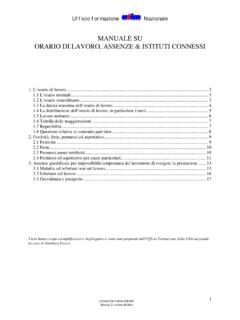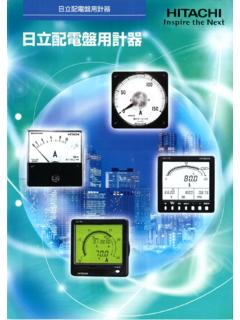Transcription of PTP 400 Series User Guide - azotel.com
1 PTP 400 Series User Guide MOTOROLA POINT-TO-POINT WIRELESS SOLUTIONS. MOTOROLA, Inc. Point-to-Point Wireless Bridges PTP 400 Series Software Release 400-09-xx System User Manual November 23rd, 2007. Ref: Copyright Information This document is the confidential property of Motorola, Inc. and without its prior written consent may not be copied or released to third parties. MOTOROLA, the stylized M Logo and all other trademarks indicated as such herein are trademarks of Motorola, Inc. Reg. Pat & Tm. Office. PTP 400 is a trademark of Motorola, Inc. All other product or service names are the property of their respective owners. 2006-2007 Motorola, Inc. All rights reserved. Compliance General Changes or modifications not expressly approved by Motorola could void the user's authority to operate the system. NOTE: This system has achieved Type Approval in various countries around the world.
2 This means that the system has been tested against various local technical regulations and found to comply. The frequency band in which the system operates is unlicensed' (except from the GHz product) and the system can be used provided it does not cause interference. Further, it is not guaranteed protection against interference from other products and installations. 1. The system has basically been shown to comply with the limits for emitted spurious radiation for a Class B digital device 1 , pursuant to Part 15 of the FCC Rules in the USA as well as comparable regulations in other countries. This equipment generates uses and can radiate radio frequency energy and, if not installed and used in accordance with the instructions, may cause harmful interference to radio communications. However, there is no guarantee that interference will not occur in a particular installation.
3 If this equipment does cause harmful interference to other equipment, which can be determined by turning the equipment off and on, the user is encouraged to try to correct the interference by one or more of the following measures: Reorient or relocate the Outdoor Unit (ODU). Increase the separation between the equipment and ODU. Connect the equipment into a power outlet on a circuit different from that to which the receiver is connected. Consult your installer or supplier for help. Deployment and Operation The Radio Regulations of various countries' limits constrain the operation of radio products generally. In particular the local regulator may limit the amount of conducted or radiated transmitter power and may require registration of the radio link. The power transmitted by the PTP 400 Series is controlled by the use of Region-specific License Keys. The following examples show how the regulatory limits apply in some specific countries at the current time.
4 Operators should note that regulations are subject to change. Contact your supplier/installer to ensure that your product is set for the correct License Key for your Country/Region and to ensure that you have fulfilled all the local regulatory requirements, especially if you are intending to use a link with external antennas. Footnotes to the table below indicate countries where registration of the link is currently mandatory. 1. Class B Digital Device, A digital device that is marketed for use in a residential environment notwithstanding use in commercial, business and industrial environments. 2. Regulations applicable to GHz PTP 400 Series Bridge variant (49400). Examples of Regulatory Limits at Power/Radiated Power/Region Setting Non-FCC and Non-ETSI Operation not currently allowed FCC FCC Part 90. Canada RSS-211. ETSI Operation not currently allowed NOTE: This product is specifically intended for professional installation.
5 The integrated antenna version may be installed as shipped from Motorola. The Connectorized version must have the Maximum Transmit Power setting reduced if it is installed with antennas having a directional gain of >26dBi (net of cable losses). The reduction is 1dB for every 1dB that the antenna gain (net of cable losses) exceeds 26dBi. See Section System Configuration Page and Section Wireless Configuration for details on adjusting the Maximum Transmit Power. 3. Regulations applicable to GHz PTP 400 Series Bridge variant (54400). Examples of Regulatory Limits at Power/Radiated Power/Region Setting Equipment can be operated in any mode, best Non-FCC and Non-ETSI 2 results will be obtained using Region 8 settings (Region 7 if DFS is required). Under FCC Regulations, operation of this product FCC is only allowed with a License Key for Region 9. (27dBm EIRP with Radar Detection).
6 Under IC Regulations, operation of this product is only allowed with a License Key for Region 10. Canada (27dBm EIRP with Radar Detection and barring of the band 5600-5650 MHz). Operation of this product is only allowed with a Thailand License Key for Region 20 (30dBm or 1W EIRP). Under ETSI Regulations, operation of this product ETSI is only allowed with a License Key for Region 9. (27dBm EIRP with Radar Detection). General Notice Applicable to Europe This equipment complies with the essential requirements for the EU R&TTE Directive 1999/5/EC. 1321. 2. Note: In regions other than EU/USA, specific local regulations may apply. It is the responsibility of the installer/user to check that the equipment as deployed meets local regulatory requirements. 4. Regulations applicable to GHz PTP 400 Series Bridge variant (58400). Examples of Regulatory Limits at Power/Radiated Power/Region Setting Equipment can be operated in any mode, best results USA/ Canada/ Taiwan/ Brazil will be obtained using Region 1 settings Under UK Regulations, operation of this product is only UK 3 allowed with a License Key for Region 4 (1W EIRP with Radar Detection).
7 Under Eire Regulations, operation of this product is Eire 4 only allowed with a License Key for Region 6 (1W. EIRP). Norwegian rules allow a 200W EIRP but also require Radar Detection (DFS) and barring of part of the band. Norway The license key for Region 7 is required, although Region 4 could also be used for lower power requirements. Australian laws prohibit use/operation of this product Australia except where it is used with a License Key for Region 3. (4W EIRP). Under Singapore Regulations, operation of this product Singapore is only allowed with a License Key for Region 5. (100mW EIRP). Under Hong Kong Regulations, operation of this Hong Kong product is only allowed with a License Key for Region 3. (4W EIRP). Under Korean regulations operation of this product is Korea only allowed with a license key for region 11 (+17 dBm and frequency band limited to 5725 to 5825 MHz).
8 3. UK Registration of Links OfCom The application form may be found at 4. Eire Registration of Links Commission for Communication Regulation (ComReg). The application form may be found at 5. General Notice Applicable to Europe This equipment complies with the essential requirements for the EU R&TTE Directive 1999/5/EC. The use of for Point-to-Point radio links is not harmonized across the EU and currently the product may only be deployed in the UK and Eire (IRL);. However, the regulatory situation in Europe is changing and the radio spectrum may become available in other countries in the near future. Please contact Motorola or the latest situation. Disclaimer The parameters quoted in this document must be specifically confirmed in writing before they become applicable to any particular order or contract. The company reserves the right to make alterations or amendments to the detail specification at its discretion.
9 The publication of information in this document does not imply freedom from patent or other rights of Motorola, Inc. or others. 6. Contents 1 About This User Guide .. 18. Interpreting Typeface and Other Conventions .. 18. Getting Additional Help .. 20. Sending Feedback .. 20. 2 Avoiding Hazards .. 21. Preventing Overexposure to RF Energy .. 21. Calculations for Separation Distances and Power Compliance 21. Calculated Distances and Power Compliance Margins .. 22. 3 Getting Started .. 23. For Your Safety .. 23. Welcome .. 24. About This 24. Who Should Use This 24. Contact Information .. 25. Repair and 25. Product Description .. 26. The Outdoor Unit (ODU) .. 28. The Power Indoor Unit - PIDU Plus .. 29. Redundancy and Alternate Powering Configurations .. 31. External DC Supply Only .. 31. External DC Supply and AC 32. External DC Supply and Redundant AC Supply .. 32. Remote LEDs and Recovery Switch.
10 33. Cables and 33. Surge Arrestor .. 34. Mounting 34. Configuration and 35. 35. 4 Product Architecture .. 36. 5 General Considerations .. 38. Spectrum Planning .. 38. Region 39. Operational 40. Radar 40. 7. RTTT Avoidance and Other Channel Use Restrictions .. 41. GHz Specific Frequency Planning Considerations .. 42. Raster 43. Fixed Frequency 43. Transmit Power Reduction at the Band Edges .. 43. GHz Specific Frequency Planning Considerations .. 43. Raster 44. Fixed Frequency 44. Transmit Power Reduction at the Band Edges .. 44. Specific Frequency Planning Considerations .. 44. Raster 45. Fixed Frequency 45. Transmit Power Reduction at the Band Edges .. 45. Distance .. 46. Networking Information .. 46. Lightning 46. Electrical Requirements .. 46. 6 Site 47. Site Selection 47. ODU Site Selection .. 47. PTP 400 Series Bridge PIDU Plus Site 47. Path Loss Considerations .. 48.




